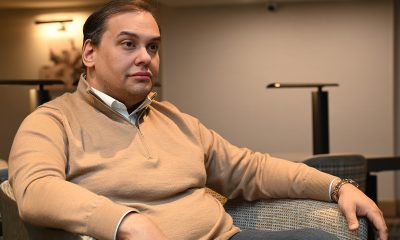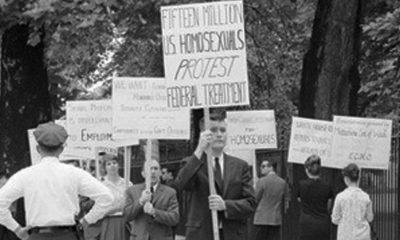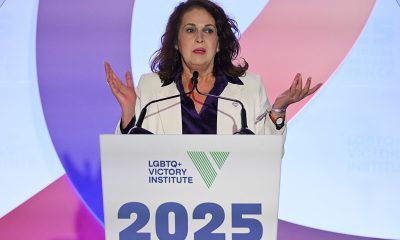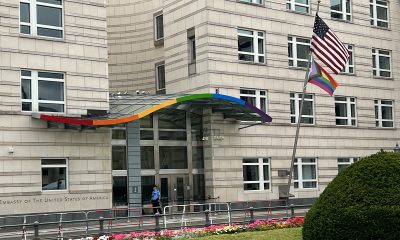Commentary
The long road to recovery
I had my first drink when I was 8 — a Sloe gin fizz.
“Sloe gin fizzy/do it till you’re dizzy/give it all you got until you’re put out of your misery.” Aerosmith said that. It was the ’80s, the decade of day-glo and hair bands. My first cassette was an album by Poison. I grew up in a small town in the suburbs of Philadelphia that was populated with middle-class Catholics, a place where neighbors used their front lawns as storage, the restaurant of choice was Friendly’s and the popular Friday night activity was tailgating down High Street while intoxicated.
I showed up to my first day of high school dressed in a rayon orchid-print button down shirt, Lee’s husky jeans and a pair of sand-colored loafers. I frequently dyed my hair, tortured it with hair gel, and had pierced ears. I got my navel pierced when I was 16 at the Jersey shore, and got my first tattoo that same year. I ran, no walked, a 16-minute mile in gym class, sneaked out for lunch at McDonald’s, and when the name calling and threats got worse in school, took refuge in the music room and “All My Children” at 3 p.m.
I felt overwhelmed — an overweight, gay, soap opera-enthusiast teen. Then came acid, LSD and the ‘90s rave scene. It was a place to escape, where people were too fucked up to care if you were gay, straight or listened to Poison. I took acid. A lot of it.
I went to my first gay bar when I was 17. Armed with a fake ID and a tube of Carmex, I tripped through the front door of Woody’s, a gay hot spot in Philadelphia, with a dream of meeting a boyfriend. He would be cute, have blond hair, blue eyes and be 19.
Fast forward three gin and tonics later: He was a brunette, had brown eyes and a limp and was 45. Every Wednesday night I would drive my Mustang into Philadelphia, booze up at Woody’s, drive home drunk and try to make it through the next day. I made friends with people who bought me drinks, better friends with the bartenders and was merely acquaintances with those I would wake up next to.
At college in Allentown, Pa., there was a new set of rules. Let’s play the game “drink till you’re no longer straight.” The theatre department was full of tomorrow’s artists who were today’s misguided youth. The drinks of choice were Zima and Natural Light. Then I discovered the beer bong, a competition featuring horny, stressed college students guzzling beer out of a hose with a funnel on one end.
And what about that boyfriend? I sought him in AOL chat rooms; those meetings seemed to go better with booze. And cigarettes. I smoked a lot of cigarettes. My vocal coach smoked cigarettes, so why couldn’t I? Finally, graduation came. Cap, check. Gown, check. Flask, check.
And now what? No more structure? I took a trip to Atlanta and didn’t come back. Atlanta introduced me to house music, 24-hour clubs, warm weather, circuit parties, and the letters E, G, K, T and C. Ecstasy, GHB/GBL, ketamine, crystal meth, and cocaine. They all made you high, and when used together, made you “crunk.” Considering that among that list, one is a solvent used to remove superglue, one is used as an anesthetic for your dog and one has been known to trigger explosions, it might cause you to think that snorting them up your nose while box-stepping to a Deborah Cox remix may not be such a good idea.
But, the drugs shrunk my waist from a 36 to a 34, made me feel socially acceptable, and were highly addictive. Ah, addiction. That force that causes you to do things over and over again expecting a different outcome. Or in the words of George Carlin, “Just cause you got the monkey off of your back, doesn’t mean the circus has left town.”
I was doing nothing with my life. I worked at Nordstrom, snorted ketamine in the stock room, boozed it up at night and blacked out. Wash, rinse, repeat.
I made the decision to go to grad school on a hit of E. I moved to Tennessee while high, I unpacked high, went to class high, studied high, met a boy drunk, got him high, and then moved in with him. We did coke and we were poor so we sold coke to pay for our coke, all the while telling ourselves that we weren’t getting in over our heads. I got in over my head and moved again.
You may want to consider your options when the list of your achievements starts looking more and more like the storyboard for a Lifetime original movie, rather than that of a successful person.
Consider the following criteria. You may be an alcoholic when you have a glass of wine at a meal and that meal is breakfast. Or, if you find you get your best eight hours of sleep from noon to 8 p.m. Or perhaps you decide to increase your fiber intake by drinking more Guinness. Or you carry around business cards that have your name and address with the phrases “Hello, I’m ____” and “Please take me to ______”.
I moved to Philadelphia and I drank. I moved to New York City and drank. I moved to Raleigh and drank. I moved back to Philadelphia and drank. I moved to D.C. and drank. It wasn’t working. No matter how much I drank, I was still not the pretty, smart, extroverted starlet that a bottle of vodka was telling me I could become.
Even though I managed to shrink my waist size to a 32, I was still terribly unhappy. I was chasing something down a long, dimly lit tunnel, with no end in sight. Blackout. Wake up. Who are you? Where am I? The walk of shame after impulses came to me from the bottom of a bottle of booze. I made many mistakes and lied a lot. My life became a fictional narrative, a choose-your-own-adventure story, with no happy endings.
It was time to do something. Something had to change. I took off my sunglasses, soaked up the daylight and asked for help. The party was over. The lights came up. “Hello, my name is John and I’m an alcoholic and drug addict.”
I haven’t had a perfect recovery. I’ve had my share of slips, trips, falls and follow-ups, but I’ve learned how to ask for help, and to listen to those willing to share their stories and suggestions. It’s not the same script, different cast, but a different script, and more diverse cast.
I’m grateful to be sober today. Addiction is always there. It’s a Christmas present neatly wrapped in sparkly paper with a glittery bow that contains an empty box. I choose the other gift. It is the gift of stories of other men and women who are recovering and shedding the burden of their pain. They are young, old, black, white, straight, gay, bi, trans, lawyers, doctors, artists, mothers, fathers, sons, daughters, grandparents, Poison fans and soap opera-enthusiasts and they all have one thing in common. They hope for a better way of living. A sober way of living.

Today, on World AIDS Day, we honor the resilience, courage, and dignity of people living with HIV everywhere especially refugees, asylum seekers, and queer displaced communities across East Africa and the world.
For many, living with HIV is not just a health journey it is a journey of navigating stigma, borders, laws, discrimination, and survival.
Yet even in the face of displacement, uncertainty, and exclusion, queer people living with HIV continue to rise, thrive, advocate, and build community against all odds.
To every displaced person living with HIV:
• Your strength inspires us.
• Your story matters.
• You are worthy of safety, compassion, and the full right to health.
• You deserve a world where borders do not determine access to treatment, where identity does not determine dignity, and where your existence is celebrated not criminalized.
Let today be a reminder that:
• HIV is not a crime.
• Queer identity is not a crime.
• Seeking safety is not a crime.
• Stigma has no place in our communities.
• Access to treatment, care, and protection is a human right.
As we reflect, we must recommit ourselves to building systems that protect not punish displaced queer people living with HIV. We must amplify their voices, invest in inclusive healthcare, and fight the inequalities that fuel vulnerability.
Hope is stronger when we build it together.
Let’s continue to uplift, empower, and walk alongside those whose journeys are too often unheard.
Today we remember.
Today we stand together.
Today we renew hope.
Abraham Junior lives in the Gorom Refugee Settlement in South Sudan.
Commentary
Perfection is a lie and vulnerability is the new strength
Rebuilding life and business after profound struggles
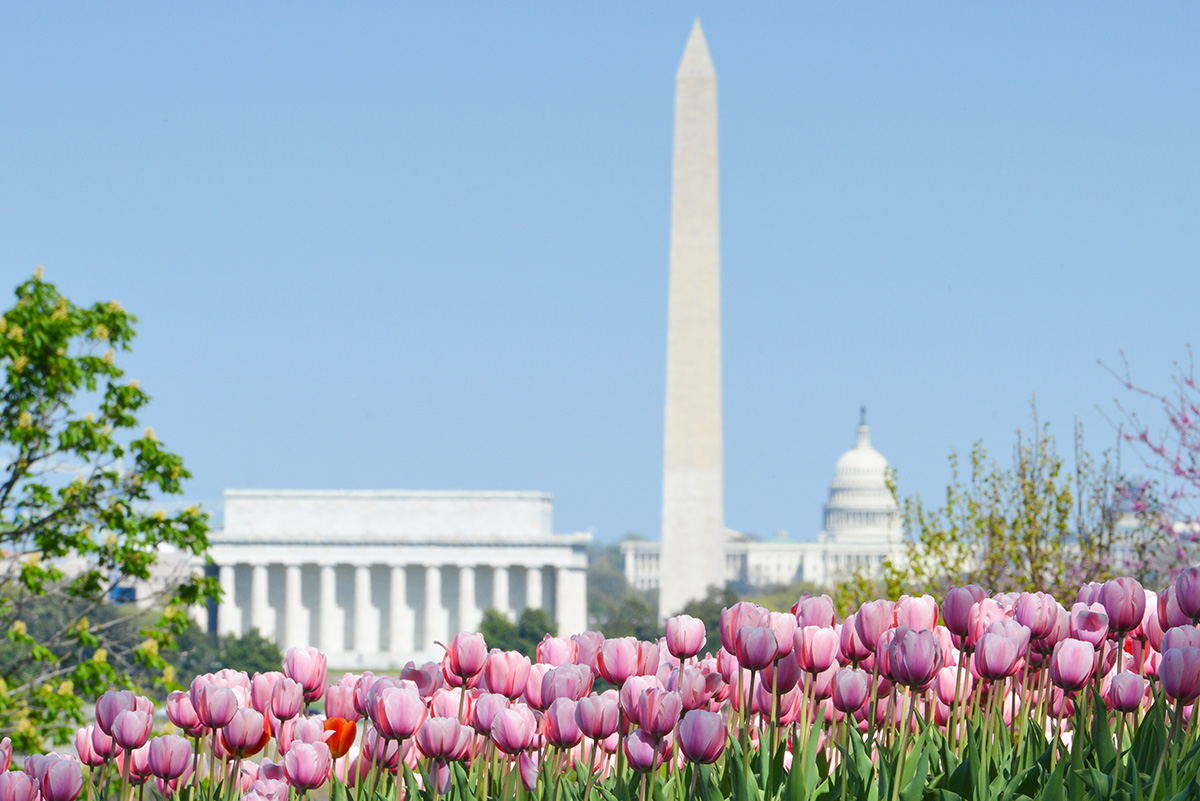
I grew up an overweight, gay Black boy in West Baltimore, so I know what it feels like not to fit into a world that was not really made for you. When I was 18, my mother passed from congestive heart failure, and fitness became a sanctuary for my mental health rather than just a place to build my body. That is the line I open most speeches with when people ask who I am and why I started SWEAT DC.
The truth is that little boy never really left me.
Even now, at 42 years old, standing 6 feet 3 inches and 225 pounds as a fitness business owner, I still carry the fears, judgments, and insecurities of that broken kid. Many of us do. We grow into new seasons of life, but the messages we absorbed when we were young linger and shape the stories we tell ourselves. My lack of confidence growing up pushed me to chase perfection as I aged. So, of course, I ended up in Washington, D.C., which I lovingly call the most perfection obsessed city in the world.
Chances are that if you are reading this, you feel some of that too.
D.C. is a place where your resume walks through the door before you do, where degrees, salaries, and the perfect body feel like unspoken expectations. In the age of social media, the pressure is even louder. We are all scrolling through each other’s highlight reels, comparing our behind the scenes to someone else’s curated moment. And I am not above it. I have posted the perfect photo with the inspirational “God did it again” caption when I am feeling great and then gone completely quiet when life feels heavy. I am guilty of loving being the strong friend while hating to admit that sometimes I am the friend who needs support.
We are all caught in a system that teaches us perfection or nothing at all. But what I know for sure now is this: Perfection is a lie and vulnerability is the new strength.
When I first stepped into leadership, trying to be the perfect CEO, I found Brené Brown’s book, “Daring Greatly” and immediately grabbed onto the idea that vulnerability is strength. I wanted to create a community at SWEAT where people felt safe enough to be real. Staff, members, partners, everyone. “Welcome Home” became our motto for a reason. Our mission is to create a world where everyone feels confident in their skin.
But in my effort to build that world for others, I forgot to build it for myself.
Since launching SWEAT as a pop up fundraiser in 2015, opening our first brick and mortar in 2017, surviving COVID, reemerging and scaling, and now preparing to open our fifth location in Shaw in February 2026, life has been full. Along the way, I went from having a tight trainer six pack to gaining nearly 50 pounds as a stressed out entrepreneur. I lost my father. I underwent hip replacement surgery. I left a relationship that looked fine on paper but was not right. I took on extra jobs to keep the business alive. I battled alcoholism. I faced depression and loneliness. There are more stories than I can fit in one piece.
But the hardest battle was the one in my head. I judged myself for not having the body I once had. I asked myself how I could lead a fitness company if I was not in perfect shape. I asked myself how I could be a gay man in this city and not look the way I used to.
Then came the healing.
A fraternity brother said to me on the phone, “G, you have to forgive yourself.” It stopped me in my tracks. I had never considered forgiving myself. I only knew how to push harder, chase more, and hide the cracks. When we hung up, I cried. That moment opened something in me. I realized I had not neglected my body. I had held my life and my business together the best way I knew how through unimaginable seasons.
I stopped shaming myself for not looking like my past. I started honoring the new ways I had proven I was strong.
So here is what I want to offer anyone who is in that dark space now. Give yourself the same grace you give everyone else. Love yourself through every phase, not just the shiny ones. Recognize growth even when growth simply means you are still here.
When I created SWEAT, I hoped to build a home where people felt worthy just as they are, mostly because I needed that home too. My mission now is to carry that message beyond our walls and into the city I love. To build a STRONGER DC.
Because strength is not perfection. Strength is learning to love an imperfect you.
With love and gratitude, Coach G.
Gerard Burley, also known as Coach G, is a D.C.-based fitness entrepreneur.
Commentary
Elusive safety: what new global data reveals about gender, violence, and erasure
Movements against gender equality, lack of human rights data contributing factors.
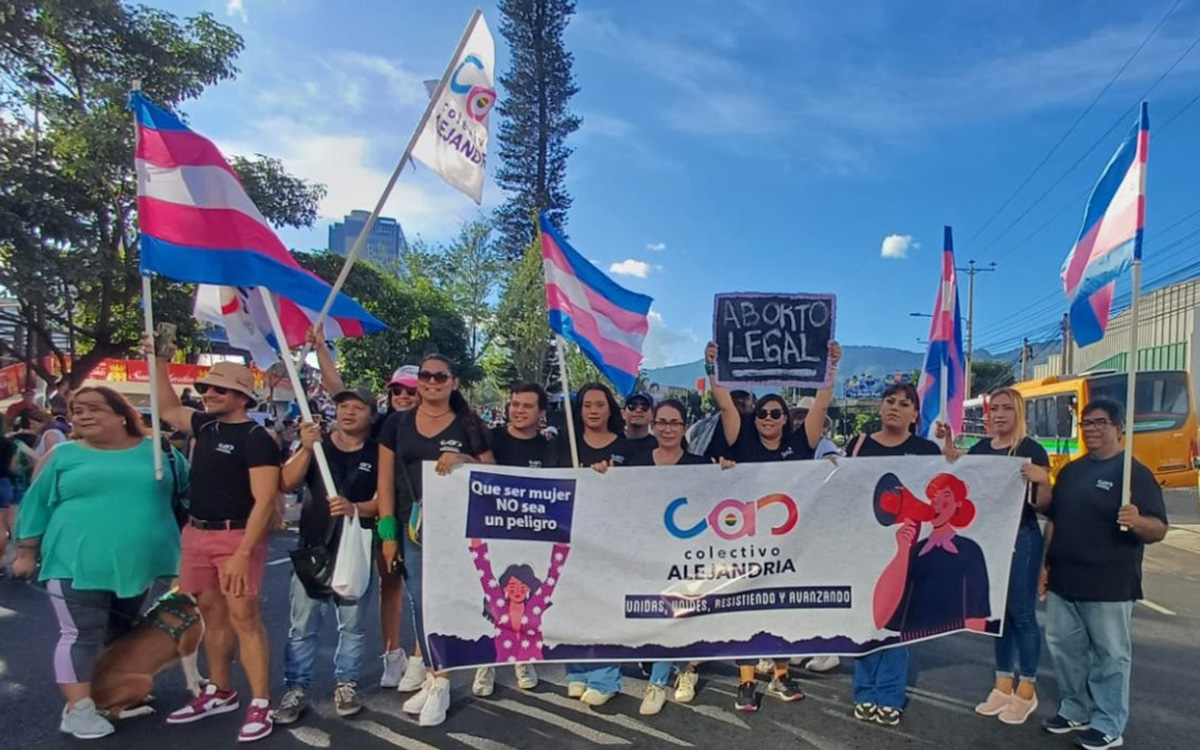
“My identity could be revealed, people can say whatever they want [online] without consequences. [Hormone replacement therapy] is illegal here so I’m just waiting to find a way to get out of here.”
-Anonymous respondent to the 2024 F&M Global Barometers LGBTQI+ Perception Index from Iraq, self-identified as a transgender woman and lesbian
As the campaign for 16 Days Against Gender-Based Violence begins, it is a reminder that gender-based violence (GBV) — both on– and offline — not only impacts women and girls but everyone who has been harmed or abused because of their gender or perceived gender. New research from the Franklin & Marshall (F&M) Global Barometers and its report A Growing Backlash: Quantifying the Experiences of LGBTQI+ People, 2022-2024 starkly show trends of declining safety among LGBTQI+ persons around the world.
This erosion of safety is accelerated by movements against gender equality and the disappearance of credible human rights data and reporting. The fight against GBV means understanding all people’s lived realities, including those of LGBTQI+ people, alongside the rights we continue to fight for.
We partnered together while at USAID and Franklin & Marshall College to expand the research and evidence base to better understand GBV against LGBTQI+ persons through the F&M Global Barometers. The collection of barometers tracks the legal rights and lived experiences of LGBTQI+ persons from 204 countries and territories from 2011 to the present. With more than a decade of data, it allows us to see how rights have progressed and receded as well as the gaps between legal protections and lived experiences of discrimination and violence.
This year’s data reveals alarming trends that highlight how fear and violence are, at its root, gendered phenomena that affect anyone who transgresses traditional gender norms.
LGBTQI+ people feel less safe
Nearly two-thirds of countries experienced a decline in their score on the F&M Global Barometers LGBTQI+ Perception Index (GBPI) from 2022-2024. This represents a five percent drop in global safety scores in just two years. With almost 70 percent of countries receiving an “F” grade on the GBPI, this suggests a global crisis in actual human rights protections for LGBTQI+ people.
Backsliding on LGBTQI+ human rights is happening everywhere, even in politically stable, established democracies with human rights protections for LGBTQI+ people. Countries in Western Europe and the Americas experienced the greatest negative GBPI score changes globally, 74 and 67 percent, respectively. Transgender people globally reported the highest likelihood of violence, while trans women and intersex people reported the highest levels of feeling very unsafe or unsafe simply because of who they are.
Taboo of gender equality
Before this current administration dismantled USAID, I helped create an LGBTQI+ inclusive whole-of-government strategy to prevent and respond to GBV that highlighted the unique forms of GBV against LGBTQI+ persons. This included so-called ‘corrective’ rape related to actual or perceived sexual orientation, gender identity, or expression” and so-called ‘conversion’ therapy practices that seek to change or suppress a person’s gender identity or expression, sexual orientation, or sex characteristics. These efforts helped connect the dots in understanding that LGBTQI+ violence is rooted in the same systems of inequality and power imbalances as the broader spectrum of GBV against women and girls.
Losing data and accountability
Data that helps better understand GBV against LGBTQI+ persons is also disappearing. Again, the dismantling of USAID meant a treasure trove of research and reports on LGBTQI+ rights have been lost. Earlier this year, the US Department of State removed LGBTQI+ reporting from its annual Human Rights Reports. These played a critical role in providing credible sources for civil society, researchers, and policymakers to track abuses and advocate for change.
If violence isn’t documented, it’s easier for governments to deny it even exists and harder for us to hold governments accountable. Yet when systems of accountability work, governments and civil society can utilize data in international forums like the UN Universal Periodic Review, the Convention on the Elimination of All Forms of Discrimination Against Women, and the Sustainable Development Goals to assess progress and compliance and call for governments to improve protections.
All may not be lost if other countries and donors fill the void by supporting independent data collection and reporting efforts like the F&M Global Barometers and other academic and civil society monitoring. Such efforts are essential to the fight against GBV: The data helps show that the path toward safety, equality, and justice is within our reach if we’re unafraid of truth and visibility of those most marginalized and impacted.
Jay Gilliam (he/him/his) was the Senior LGBTQI+ Coordinator at USAID and is a member of the Global Outreach Advisory Council of the F&M Global Barometers.
Susan Dicklitch-Nelson (she/her/hers) is the founder of the F&M Global Barometers and Professor of Government at Franklin & Marshall College.



